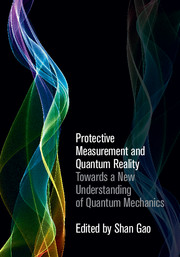Book contents
- Frontmatter
- Dedication
- Contents
- List of Contributors
- Preface
- Acknowledgements
- 1 Protective measurement: an introduction
- Part I Fundamentals and applications
- Part II Meanings and implications
- 7 Measurement and metaphysics
- 8 Protective measurement and the explanatory gambit
- 9 Realism and instrumentalism about the wave function: how should we choose?
- 10 Protective measurement and the PBR theorem
- 11 The roads not taken: empty waves, wave function collapse and protective measurement in quantum theory
- 12 Implications of protective measurement on de Broglie–Bohm trajectories
- 13 Entanglement, scaling, and the meaning of the wave function in protective measurement
- 14 Protective measurement and the nature of the wave function within the primitive ontology approach
- 15 Reality and meaning of the wave function
- Index
- References
14 - Protective measurement and the nature of the wave function within the primitive ontology approach
from Part II - Meanings and implications
Published online by Cambridge University Press: 05 January 2015
- Frontmatter
- Dedication
- Contents
- List of Contributors
- Preface
- Acknowledgements
- 1 Protective measurement: an introduction
- Part I Fundamentals and applications
- Part II Meanings and implications
- 7 Measurement and metaphysics
- 8 Protective measurement and the explanatory gambit
- 9 Realism and instrumentalism about the wave function: how should we choose?
- 10 Protective measurement and the PBR theorem
- 11 The roads not taken: empty waves, wave function collapse and protective measurement in quantum theory
- 12 Implications of protective measurement on de Broglie–Bohm trajectories
- 13 Entanglement, scaling, and the meaning of the wave function in protective measurement
- 14 Protective measurement and the nature of the wave function within the primitive ontology approach
- 15 Reality and meaning of the wave function
- Index
- References
Summary
Introduction
One of the crucial issues about protective measurements is the extent to which they provide (additional) grounds for some realist understanding of the wave function. This issue is notoriously subject to debate, which is not the aim of this chapter. Rather, this chapter aims at clarifying the further issue of the ontological picture corresponding to the realist understanding of the wave function possibly suggested by protective measurements. Oddly enough, proponents of a realist reading of protective measurements remain in general rather vague about ontology (see for instance Aharonov et al. (1993, 4624), who assimilate the wave function to an “extended object” without further details, or the brief and somewhat unprecise discussion in Dickson (1995, 135–136) of the interpretation of the wave function within Bohmian mechanics (BM) and within the theoretical framework elaborated by Ghirardi, Rimini and Weber (GRW); in this volume, Gao does propose a more elaborated ontological model for quantum mechanics (QM) based on protective measurements).
Despite this vagueness (or maybe because of it), it seems that the most obvious ontological intuition resulting from protective measurements points towards some form of straightforward realism about the wave function understood in the sense of a real, physical field: indeed, protective measurements are claimed to allow measuring expectation values of observables on a single quantum system, thereby providing the possibility of reconstructing (i.e. “measuring” in some sense) the wave function of a single quantum system. Aharonov et al. (1996, 125) clearly express this intuition: “We can observe the expectations values of operators, and we can observe the density and the current of the Schrödinger wave. We can “see” in some sense the Schrödinger wave. This leads us to believe that it has physical reality.”
Therefore, this kind of intuition seems in line with a realist conception of the wave function, according to which the wave function is considered as a real substantial, material in some sense) entity on its own (this view is often called “wave function realism”).
- Type
- Chapter
- Information
- Protective Measurement and Quantum RealityTowards a New Understanding of Quantum Mechanics, pp. 195 - 210Publisher: Cambridge University PressPrint publication year: 2015



